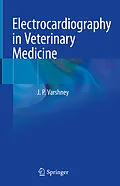This book provides essential information on methodologies for recording electrocardiograms in various animal species, including dogs, cats, cattle, buffaloes, sheep, goats, mithun, chelonians, snakes, avians, equines, rabbits, and the Indian gray mongoose. It also reviews the electrocardiographic physiology, generation of electrocardiograms, and normal criteria for various animal species; electrocardiograms in health and disease; and the interpretation of abnormal electrocardiograms, cardiomyopathy and arrhythmias, with corresponding treatment protocols.
Further, it presents several approaches to interpreting the electrocardiograms of dogs, cats, ruminants, tortoises, pigeons, and other animals, offering a valuable resource for all veterinary students, scientists, and physicians wanting to make greater use of this valuable non-invasive tool in the diagnosis of heart diseases and general health examinations.
Autorentext
Prof. J. P. Varshney has served as a Professor at the Division of Veterinary Medicine, Indian Veterinary Research Institute, Izatnagar; National Research Centre on Equines, Hisar; and Indian Grassland and Fodder Research Institute, Jhansi. He is a respected scientist with 53 years of experience, including 11 years of teaching at the graduate level. Although he retired from ICAR in 2007, he is still contributing to the field of Veterinary Medicine as a Senior Consultant (Medicine) at Nandini Veterinary Hospital, Surat (Gujarat). He is the recipient of 33 honors and awards, including a Dr. K. S. Nair Memorial Gold Medal-1990, Dr. C.G. Bhaskar Gold Medal-1996, Ram Lal Agrawal Gold Medal-1997 for contributions to veterinary medicine, Award of Merit-2001 and Award of Honour-2002 (IVRI Izatnagar for contributions in Research and Academics), Best Teacher Award 2003-2004 (IVRI, Izatnagar), PETCARE Award for Canine Excellence-2005, and Intas Polivet best clinical and research article awards (6 times). In recognition of his contributions to veterinary homeopathy, he was appointed as a member of the Consultative Committee of Experts in Veterinary Science, and served on the Special Committee for Fundamental Research in Homoeopathy at CCRH, New Delhi (Ministry Of Ayush, Govt. of India). He has published over 300 research and clinical papers in leading national/international journals, and authored two book chapters and one book.
Inhalt
Chapter 1_Cardiac Evaluation Approach. -Chapter 1.1. History and physical examination, Auscultation. -Chapter 1.2. Blood Pressure, Electrocardiography, Echocardiography. -Chapter 1.3. Angiocardiography, Thoracic radiography, Nuclear Imaging. -Chapter 1.4. Cardiac Biomarkers. -Chapter 2. Electrocardiography, its uses and limitations. -Chapter 2.1. Electrocardiograph, Electrocardiography, Electrocardiogram. -Chapter 2.2. History and Development. -Chapter 2.3. Uses of electrocardiography. -Chapter 2.4. Utility of electrocardiography. -Chapter 2.5. Limitations of Electrocardiogram. -Chapter 2.6. The Electrocardiograph and recording. -Chapter 2.7. Common artifacts and their management. -Chapter 2.8. Misplacement of Electrodes. -Chapter 3. Generation and shape of electrocardiogram. -Chapter 3.1. Electrocardiogram and expectations. -Chapter 3.2. Electrical activity in cardiac cells. -Chapter 3.3. Current generation and conduction system in heart. -Chapter 3.4. Conduction and Electrocardiogram. -Chapter 3.5. Shape of ECG. -Chapter 3.6. Clinical Indications for taking an ECG. -Chapter 3.7. Electrocardiographic Physiology. -Chapter 3.8. Measurement details of wave and intervals. -Chapter 3.9. Interpretations of normal cardiac wave forms. -Chapter 3.10. Heart rate variability. -Chapter 3.11. Q-T interval variability. -Chapter 4. A Systematic reading of an electrocardiogram. -Chapter 4.1. Systematic approach to ECG. -Chapter 4.2. Record keeping. -Chapter 4.3. Clinical information obtainable from electrocardiogram. -Chapter 5. Benchmarks for normal electrocardiogram. -Chapter 5.1.Benchmark for normal electrocardiogram for dogs. -Chapter 5.2. Effect of breed, age, sex on ECG. -Chapter 6. Abnormal wave forms, segments and intervals in electrocardiogram. -Chapter 7. Atrial and Ventricular enlargement patterns. -Chapter 8. Intraventricular conduction abnormality and Bundle branch block patterns. -Chapter 8.1. Left Bundle Branch Block. -Chapter 8.2. Left Anterior Fascicular Block. -Chapter 8.3. Right Bundle Branch Block. -Chapter 8.4. Right Bundle Branch and Left anterior Fascicular Block. -Chapter 9. ECG waves enlargement patterns and clinical Associations. -Chapter 10. ECG patterns associated with electrolyte Imbalances. -Chapter 11. ECG patterns associated with drug toxicities. -Chapter 12. Physical and Chemical agents affecting cardiovascular system. -Chapter 13. Cardiac Arrhythmias. -Chapter 13.1. Prevalence. -Chapter 13.2. Classification. -Chapter 13.3. Conduction disturbances. -Chapter 13.4. Precipitating Factors. -Chapter 13.5. Diagnostic criteria. -Chapter 13.6. Electrocardiographic features. -Chapter 14. Clinical conditions associated with arrhythmias and conduction disturbances. -Chapter 15. Clinical management of arrhythmias. -Chapter 15.1. General Considerations. -Chapter 15.2. Treatment of specific arrhythmia. -Chapter 15.3. Anti-arrhythmic drugs. -Chapter 15.4. Homeopathic drugs. -Chapter 15.5. Anti-arrhythmic drugs at a glance with doses and use. -Chapter 16. Electrocardiographic findings in cardiac diseases. -Chapter 17. Electrocardiographic findings in non-cardiac diseases. -Chapter 18. Canine cardiomyopathy. -Chapter 18.1. Dilated cardiomyopathy. -Chapter 18.2. Hypertrophic cardiomyopathy. -Chapter 18.3. Doberman Pincher occult cardiomyopathy. -Chapter 18.4. Boxer. -Chapter 18.5. Secondary myocarditis. -Chapter 18.6. Infectious myocarditis. -Chapter 19. Bacterial endocarditis. -Chapter 20. Heart Failure . -Chapter 20.1. Diagnostic Approach. -Chapter 20.2. Treatment. -Chapter 20.3. Refractory Congestive Heart Failure. -Chapter 20.4. Use of Pimodendan in heart failure. -Chapter 20.5. Common Drugs for heart failure at a glance. -Chapter 21. Pericardial Effusion. -Chapter 22. Cardiopulmonary Arrest. -Chapter 23. Valvular Insufficiency. -Chapter 23.1. Chronic Mitral Insufficiency. -Chapter 23.2. Tricuspid Insufficiency. -Chapter 23.3. Mitral Stenosis. -Chapter 23.4. Aortic Insufficiency. -Chapter 23.5. Pulmonic Insufficiency. -Chapter 24. Cardiogenic Shock. -Chapter 25. Canine Electocardiograms in diseases. -Chapter 26. Electrocardiography in Cats. -Chapter 26.1. Differences between Dog and Cat. -Chapter 26.2. Positioning and Placement of electrodes. -Chapter 26.3. Electrocardiogram and Electrocardiographic indices. -Chapter 26.4. No...
Titel
Electrocardiography in Veterinary Medicine
Autor
EAN
9789811536991
Format
E-Book (pdf)
Hersteller
Veröffentlichung
29.10.2020
Digitaler Kopierschutz
Wasserzeichen
Dateigrösse
18.48 MB
Anzahl Seiten
291
Unerwartete Verzögerung
Ups, ein Fehler ist aufgetreten. Bitte versuchen Sie es später noch einmal.
